The Politburo issued a Resolution on breakthroughs in education and training development.
General Secretary To Lam signed and issued Resolution No. 71-NQ/TW of the Politburo on breakthroughs in education and training development.
The Resolution clearly states 6 guiding viewpoints; specific goals by 2030, 2035, vision to 2045; 8 tasks and solutions.
Specifically, the goal by 2030 is to expand equitable access and improve the quality of preschool and general education to reach advanced levels in the Asian region. Build a network of basic schools to meet the learning needs of students of all subjects and regions; have at least 80% of general schools meet national standards.
Complete universal preschool education for children aged 3 to 5 and compulsory education for all secondary schools; at least 85% of people of the right age complete high school or equivalent, with no province or city achieving less than 60%. Achieve initial results in improving technological capacity, artificial intelligence and English proficiency at the secondary level.
The education index contributes to the human development index (HDI) reaching over 0.8, in which the education inequality index falls below 10%.
Building and training human resources, especially high-quality human resources, to meet the requirements of Vietnam becoming a developing country with modern industry and high average income. The network of higher education and vocational education facilities is arranged appropriately and invested in upgrading; striving for 100% of higher education facilities and at least 80% of vocational education facilities to meet national standards, 20% of facilities to be invested in modernly equivalent to developed countries in Asia.
The proportion of people of the age group studying at post-secondary levels reaches 50%. The proportion of workers with college or university degrees or higher reaches 24%. The proportion of people studying basic sciences , engineering and technology reaches at least 35%, including at least 6,000 postgraduate students and 20,000 people studying in talent programs. The human capital and research index contributing to the global innovation index (GII) is on par with upper-middle-income countries.
Elevate higher education institutions to become truly national and regional centers of research, innovation, and entrepreneurship. The network of higher education institutions plays a pivotal role in the innovation ecosystem of regions and localities, providing high-quality human resources and talents to meet the requirements of key industries and fields; recruiting at least 2,000 excellent lecturers from abroad.
Increase the average of 12%/year for the number of international scientific publications, revenue from science, technology, innovation; 16%/year for the number of patent registrations, patent protection certificates. Strive for at least 8 higher education institutions to be in the top 200 universities in Asia, at least 1 higher education institution to be in the top 100 universities in the world in a number of fields according to prestigious international rankings.

Target by 2035: The education and training system continues to be modernized, with strong and steady progress in access, equity and quality. Complete universal upper secondary education and equivalent; the education index contributing to the HDI index reaches over 0.85; the human capital and research index contributing to the GII index reaches above the average of upper middle-income countries. Strive for at least 2 higher education institutions to be among the top 100 universities in the world in a number of fields according to prestigious international rankings.
Vision to 2045: Vietnam has a modern, equitable and high-quality national education system, ranked among the top 20 countries in the world. All people have the opportunity to learn throughout their lives, improve their qualifications and skills and develop their personal potential to the fullest. High-quality human resources, scientific and technological talents become the driving force and core competitive advantage of the country, contributing to making Vietnam a developed, high-income country. Strive for at least 5 higher education institutions to be among the top 100 universities in the world in a number of fields according to prestigious international rankings.
The tasks and solutions set forth in Resolution 71/NQ-TW include:
Raising awareness, innovating thinking and action, and determining strong political determination to make breakthroughs in education and training development.
Strongly innovate institutions, create unique and outstanding mechanisms and policies for education and training development.
Strengthening comprehensive education of morality, intelligence, physique and aesthetics, forming a system of values for Vietnamese people in the new era.
Comprehensive digital transformation, popularization and strong application of digital technology and artificial intelligence in education and training.
Focus on building a team of teachers and standard school facilities, improving the quality of preschool and general education.
Reform and modernize vocational education, creating a breakthrough in developing human resources with high vocational skills.
Modernize and improve university education, create breakthroughs in developing highly qualified human resources and talents, and lead research and innovation.
Promote deep international cooperation and integration in education and training.
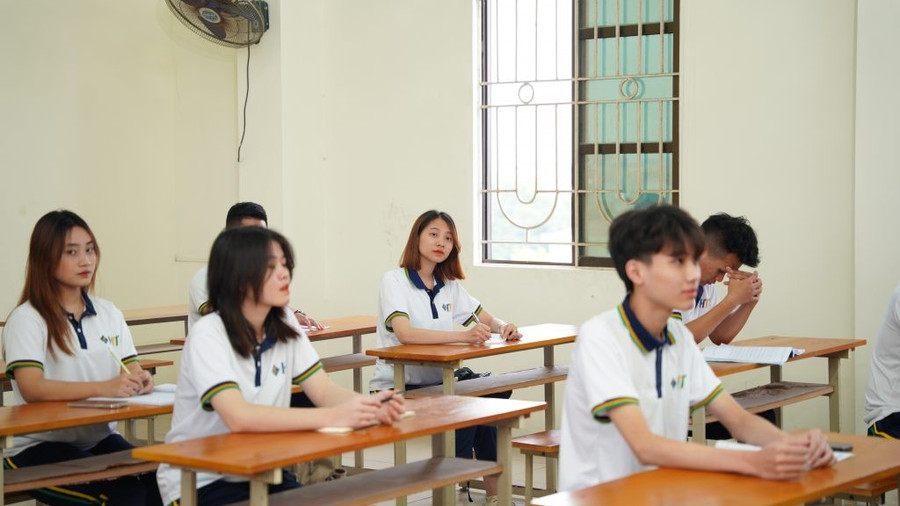
Candidates confirm university admission online
Starting from 8:00 a.m. on August 25, admitted candidates will begin to confirm their admission online on the Ministry of Education and Training's General Admission System. Based on this year's enrollment, the Ministry of Education and Training has decided to extend the system by 3 days, opening it until 5:00 p.m. on September 2 (instead of the original August 30) to facilitate candidates and handle any technical issues that may arise.
In 2025, the total number of candidates registering for the exam will reach 852,000 with 7.6 million applications for more than 4,000 majors and training programs of more than 400 universities and colleges nationwide.
The admission regulations allow candidates to register for multiple wishes without having to choose an admission method or combination. The admission software system will automatically select the most beneficial admission method or combination for the candidate.
Therefore, the total number of actual admission wishes that must be considered on the system is up to over 50 million (each industry wish considered by each method and admission combination is considered as one wish on the system), an increase of about 2 times compared to 2024.
The consistent policy of the Ministry and schools is to transfer difficult and complicated tasks to themselves and apply technology to solve them, bringing maximum convenience and fairness to candidates. From the registration process, paying fees to confirming admission, candidates do it all online.
To meet the higher demands of 2025, the general enrollment support software system (including the virtual selection and filtering system) has been upgraded. Although there was an initial overload, it was promptly resolved and completed processing, providing data to schools for timely announcement on August 22.
The Ministry of Education and Training also increased the time and number of virtual filtering times for schools to carefully review data and minimize errors. At the same time, after announcing the benchmark scores, schools will need 2 to 3 days to review, correct errors and complete the list of successful candidates, notify candidates, and update the Ministry's system to serve candidates to confirm admission.
The Ministry of Education and Training said that with a huge amount of data, along with diverse admission methods and conditions of universities and colleges, errors are inevitable, even at a very small rate.
However, due to careful preparation and experience from previous years, the actual number of errors decreased significantly compared to 2024.
After listening to feedback on major errors of a number of higher education institutions, the Ministry of Education and Training has promptly directed and guided, and so far most of the errors have been resolved in accordance with regulations.
Regarding this content, last week Deputy Minister of Education and Training Hoang Minh Son also shared with the press.
Accordingly, the Deputy Minister commented that this year's admission season shows positive signs: high benchmark scores in some majors are not unusual but reflect good differentiation, the sharp increase in the number of absolute scores in block A0 proves the outstanding abilities of many students, while strategic majors such as artificial intelligence, chip technology, and pedagogy attract a large number of candidates, in line with the national human resource orientation.
One of the important changes for the 2025 admissions is that the Ministry of Education and Training requires schools to convert admission scores to the same level between admission methods. This is to ensure that, whether candidates are admitted by high school graduation exam, transcript or competency assessment test, the final benchmark score reflects the same level of input competency.
This year, the "virtual filtering" system is operated in many rounds to ensure that each candidate is considered for their highest choice. The multi-round process is to gradually bring the entire system to a common equilibrium point.
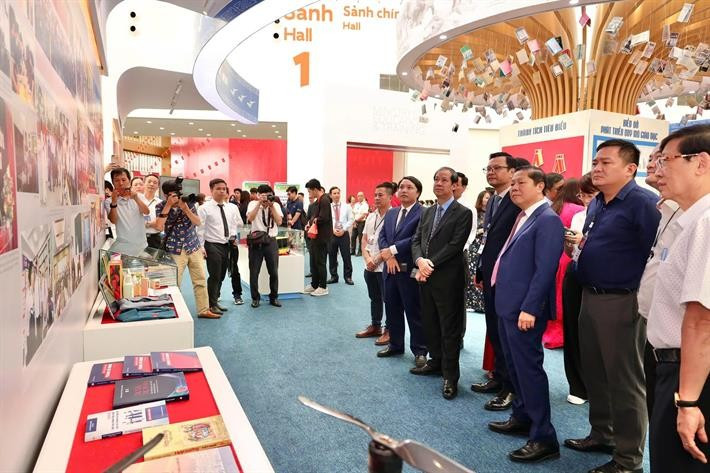
Continuing activities to celebrate 80 years of tradition in the Education sector
On the morning of August 28, the opening ceremony of the National Achievements Exhibition with the theme "80 Years of the Journey of Independence - Freedom - Happiness" took place at the National Exhibition Center (Hanoi).
In the exhibition area of the central ministries and branches, the exhibition booth of the Ministry of Education and Training with the theme "80 years of Education and Training for national development" attracted the attention of many people.
With an area of 396m², the exhibition booth is designed in a modern style, applying digital technology and interactive technology, honestly and vividly reflecting the development journey of Vietnam's revolutionary education through 6 historical stages: from the "Eradicating Ignorance" movement (1945-1954), educational reforms, to the current fundamental and comprehensive innovation of education and training.
The exhibition is an opportunity to honor the outstanding achievements of the education sector, affirming the key role and historical mission of education in the cause of building and defending the Fatherland and international integration; at the same time, spreading the spirit of "respecting teachers", encouraging generations of students to follow in the footsteps of their predecessors, contributing to building an increasingly prosperous, civilized and happy country.
The exhibition opens from August 28 to September 5, 2025 at the National Exhibition Center (Hanoi).
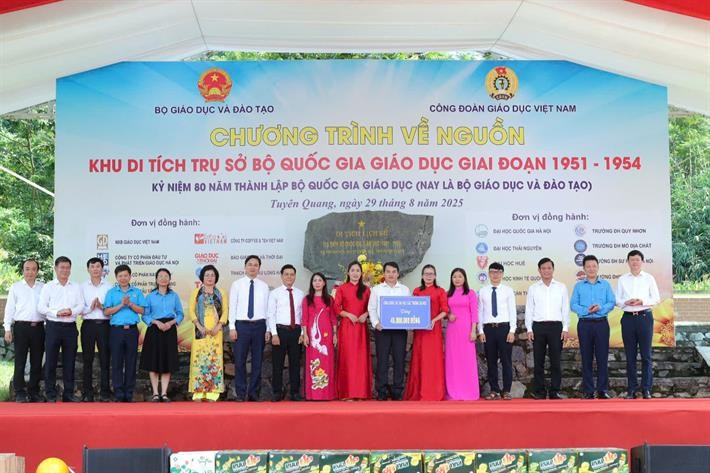
On August 29, the Ministry of Education and Training coordinated with the Vietnam Education Trade Union to organize a gratitude and origin program at the National Education Ministry Relic Site, Khuon Tru village, Yen Nguyen commune, Tuyen Quang province.
This meaningful event aims to review the 80-year tradition of formation, construction and development of the Ministry of Education and Training. At the same time, it educates historical traditions and arouses the pride and gratitude of today's generations towards previous generations of teachers, who have written a beautiful history, a solid foundation for a new journey, in a new era with new achievements of Vietnamese Education.
On this occasion, the Ministry of Education and Training, Vietnam Education Trade Union, and Vietnam Education Publishing House presented gifts and support to teachers and students who have overcome difficulties to teach and study well; and presented gifts to the Cultural House and residents of Khuon Tru village.
Innovation and improvement of education quality in ethnic minority and mountainous areas
On August 26, in Hanoi, the Ethnic Council, the Committee for Culture and Social Affairs, the Ministry of Education and Training and the Ministry of Ethnic Minorities and Religions jointly organized a national workshop on "Innovation and improvement of the quality of education and training in ethnic minority and mountainous areas; current situation, challenges and solutions".
Reporting at the workshop, Director of the Department of General Education (Ministry of Education and Training) Thai Van Tai said:
With the special attention of the Party and the State; the guidelines and policies are institutionalized into a system of increasingly complete, relatively complete and synchronous legal documents; the policies are seriously and promptly organized and implemented by all levels, sectors and localities, with the people's consent and support..., the cause of education and training in ethnic minority and mountainous areas has had significant changes.
Firstly, the planning and construction of a network of schools from kindergarten to primary, secondary and high school has been expanded and developed widely in residential areas. Schools have been built in remote villages and hamlets to meet the learning needs of the people.
Second, regarding the quality of mass education, the universalization of education in all ethnic minority and mountainous areas has been and is completing its basic goals. The rate of preschool children and students going to school is increasing; the number of primary and secondary school dropouts is decreasing.
On average, in the past 5 years, the rate of mobilizing ethnic minority preschool children (5 years old) to attend class has reached 98% (the national rate is 99%). The rate of mobilizing primary school students of school age nationwide to attend class is 98.31%. The rate of mobilizing primary school students of school age to attend class is 97.25%.
The national rate of junior high school students graduating from junior high school is about 98.40%. For ethnic minority and mountainous areas, the rate of junior high school students graduating from junior high school is 98.24%. The national rate of high school students graduating from high school is 98.40%. For ethnic minority and mountainous areas, the rate of high school students graduating from high school is 98.16%.
The indicators of mass education in ethnic minority areas are approximately the same as the national average, less than 1% lower. However, the rate of advanced education and the rate of going to high school or higher in ethnic minority areas is much lower than the national average.
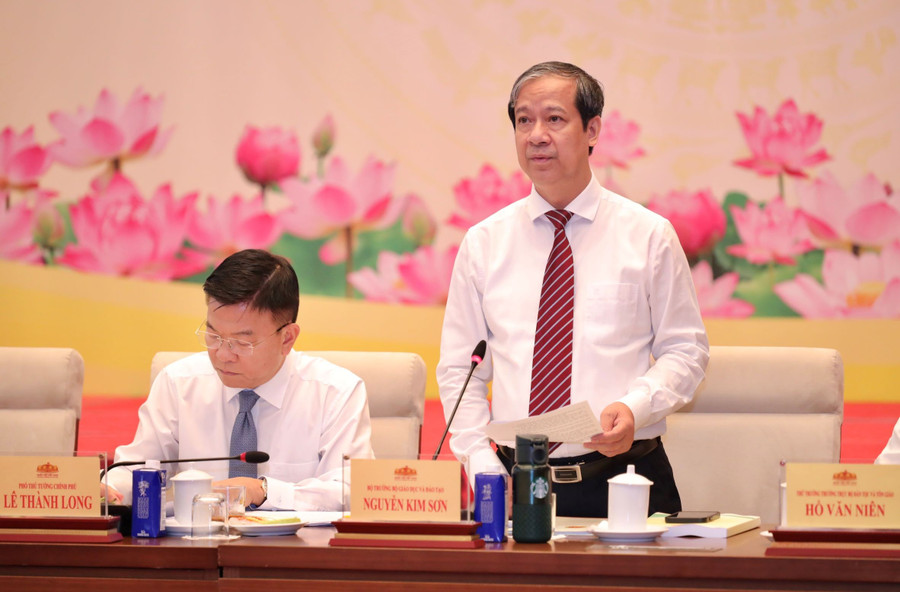
At the workshop, Minister of Education and Training Nguyen Kim Son acknowledged valuable contributions and shared new perspectives on challenges and solutions for education in ethnic minority and mountainous areas.
From the analysis of the challenges, the Minister emphasized a number of important solutions. In particular, it is necessary to have a policy to sustainably develop the local teaching force and teachers from ethnic minorities. Promote digital transformation to overcome geographical gaps, solve the problem of teacher shortages and bring quality education everywhere through online training and digital platforms. Review, plan and systematize this entire policy.
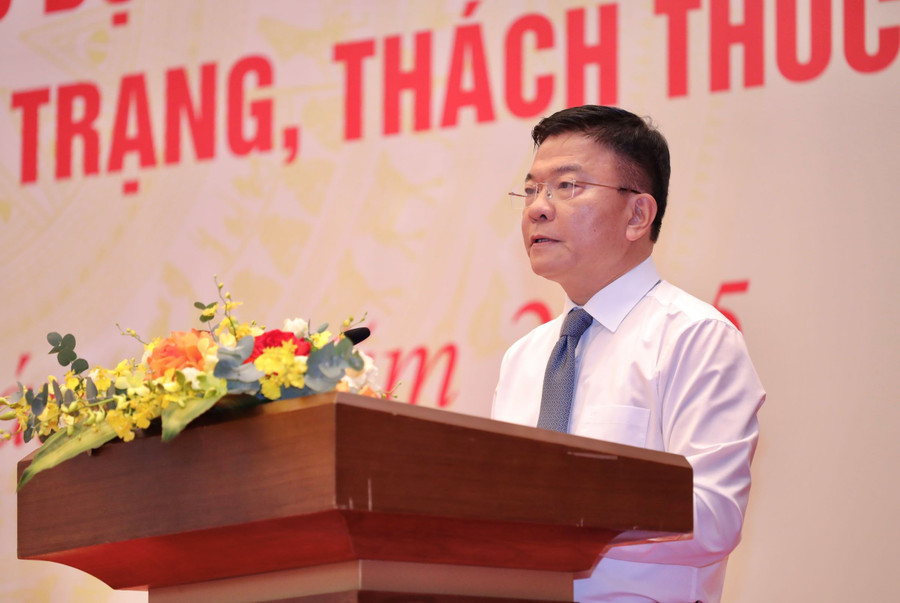
Speaking at the workshop, Deputy Prime Minister Le Thanh Long acknowledged the achievements in developing education and training in ethnic minority and mountainous areas in recent times. Besides the achievements, the Deputy Prime Minister also pointed out the difficulties and challenges.
To address the above challenges, the Deputy Prime Minister proposed reviewing, systematizing and improving the effectiveness of policies. Focusing resources on implementing policies that have been issued but have not been implemented effectively; finding the root causes of this. At the same time, effective policies should continue to be promoted. Additional solutions need to be truly new breakthroughs.
Along with that, re-plan the school network appropriately, especially in conjunction with the organization of two-level local government. Prioritize and effectively use investment resources. Focus on improving and enhancing the quality of education...
Source: https://giaoducthoidai.vn/nong-trong-tuan-nghi-quyet-dot-pha-phat-trien-gd-dt-xac-nhan-nhap-hoc-dai-hoc-post746617.html




![[Photo] Parade to celebrate the 50th anniversary of Laos' National Day](/_next/image?url=https%3A%2F%2Fvphoto.vietnam.vn%2Fthumb%2F1200x675%2Fvietnam%2Fresource%2FIMAGE%2F2025%2F12%2F02%2F1764691918289_ndo_br_0-jpg.webp&w=3840&q=75)

![[Photo] Worshiping the Tuyet Son statue - a nearly 400-year-old treasure at Keo Pagoda](/_next/image?url=https%3A%2F%2Fvphoto.vietnam.vn%2Fthumb%2F1200x675%2Fvietnam%2Fresource%2FIMAGE%2F2025%2F12%2F02%2F1764679323086_ndo_br_tempimageomw0hi-4884-jpg.webp&w=3840&q=75)




































































































Comment (0)